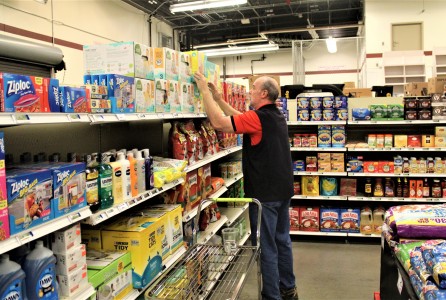UMASS SURVEY OF ESSENTIAL WORKERS DURING PANDEMIC SHOWS WIDESPREAD HEALTH AND SAFETY CONCERNS

67 percent of grocery and other retail workers responding to a UMass survey reported feeling unsafe at work. Photo: army.mil
Source: UMASS NEWS AND MEDIA
Half of survey respondents report feeling unsafe at work, low-wage workers are two-to-three times more likely than high-wage workers to lack access to basic safety measures
Researchers at the University of Massachusetts Amherst Labor Center have released a new report providing some of the first data on the safety and security of essential workers during the COVID-19 pandemic.
Clare Hammonds and Jasmine Kerrissey conducted an online survey of over 1,600 essential workers in Western Massachusetts who were at work between April 17-24. As of late April, Massachusetts had the third-highest COVID-19 case count of all states, and two cities in Western Massachusetts ranked among the cities with the highest death rates per 1,000 population in the country — Springfield at No. 7 and Greenfield at No. 11, according to data compiled by The New York Times.
More than half (51 percent) of essential workers surveyed reported that they do not feel safe at work. Sixty-five percent said that they are unable to practice social distancing, 29 percent that they did not receive COVID-19 transmission training, 21 percent that they lack masks, 17 percent that they lack hand sanitizer, 8 percent that they lack regular hand washing opportunities. In addition, 16 percent were asked by their employers not to share their health information with coworkers.
The full report, “A Survey of Essential Workers’ Safety and Security During COVID-19,” is available online as part of the UMass Amherst Labor Center’s Working Paper Series
“Essential workers sustain our ability to live during this crisis, going to work to provide critical food, shelter, transportation, health and safety in a range of industries from healthcare and transportation to social services and public safety,” says Hammonds, Professor of Practice in the UMass Amherst Labor Center. “Essential workers risk exposure to COVID-19 without proper safety precautions. The findings of this research provide important insight into how to protect the workforce as we begin to re-open the economy.”
The survey also found:
- 67 percent of grocery and other retail workers reported feeling unsafe at work, which is greater than healthcare workers (51 percent).
- Low-wage workers (less than $20/hour), were two to three times more likely than high-wage workers (more than $40/hour) to lack access to basic safety measures, including masks, hand sanitizer, regular handwashing, and training.
- Substantial numbers of low-wage workers reported that they had been unable to meet their family’s food needs (34 percent), housing needs (9 percent), and childcare needs (16 percent) in the last week.
- 38 percent of Latino essential workers reported food insecurity, compared to 21 percent of their white counterparts.
- About half of the survey’s respondents (52 percent) reported that their work had become more intense.
- Only 20 percent reported receiving hazard pay.
- 17 percent of essential workers lacked paid sick leave, and roughly half reported that they are unable to use paid time-off if a family member falls ill.
“Health and safety protections, hazard pay, greater enforcement of municipal ordinances, and protection of workers’ rights to self-organize are critical to improving worker safety,” says Kerrissey, Assistant Professor of Sociology in the Labor Center.
When asked about what they need, a convenience store worker said, “The part that makes me feel unsafe is the customers. People are only supposed to come out for essential things and that is not the case. People that are staying at home come in for a cup of coffee five times a day…People do not know the difference between what they want and what they need…. About 50 percent of guests have no concept of six feet. They think because our backs are to each other it’s fine…or just quickly getting a coffee it’s OK to be within 6 feet of each other.”
A low-wage retail worker said, “We are risking infecting our family by working, and they don’t give us anything extra in our paychecks to be able to buy more food, what we earn is for paying rent, electricity, insurance, and the rest is barely enough to buy food.”
The survey recruited participants using Facebook advertisements targeted to residents of Western Massachusetts, and respondents were invited to participate if they were working in-person (not remotely) as of April 15. Respondents then completed a 10-minute survey that asked a range of questions focused on health, safety, and workers’ access to food, housing and childcare. Hammonds and Kerrissey have repeated the survey for the entire state of Massachusetts for the period of April 24 to May 1, and the researchers say subsequent results will be used to understand how essential workers’ experiences change as the pandemic evolves.
